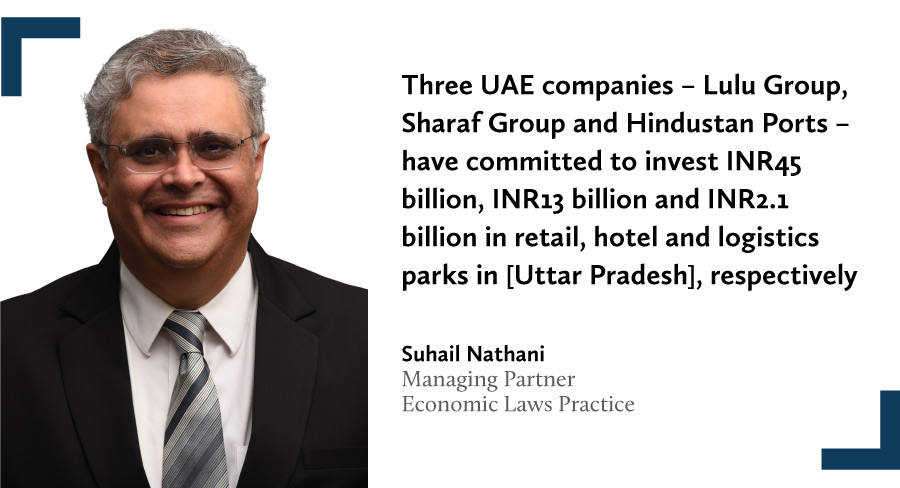UAE trade pact is spearheading regional interest in India, writes Vandana Chatlani
February 2023 was the first anniversary of the signing of the Comprehensive Economic Partnership Agreement (CEPA) between India and the United Arab Emirates (UAE). The pact is the first bilateral trade agreement signed by the UAE, and India’s first bilateral trade agreement in the Middle East and North Africa region. Through the accord, both India and the UAE have ambitions to boost trade from USD60 billion to USD100 billion during the next five years.
In a tweet in February, Thani Al Zeyoudi, the UAE’s minister of state for foreign trade, said non-oil trade between India and the UAE had increased by 10% to almost USD50 billion since the CEPA came into force. The statistics signalled “a powerful economic alliance that promises to help unlock the Asian future and shape the trade routes of tomorrow”, wrote Al Zeyoudi. “The economic centre of gravity is shifting south and east – and #IndiaUAECEPA puts us both right at its centre.”
If multilateral trade expansion into the Middle East is India’s goal, the CEPA is the sharp edge of developments. Mitul Kaushal, an economist and member of the international trade and customs team at Economic Laws Practice in New Delhi, predicts that Gulf Co-operation Council (GCC) economies will also soon witness an upswing in investment from India following announced plans to resume talks on a free-trade agreement.
The fact that this is being discussed once again is encouraging, says Kaushal. “Moreover, the India-UAE CEPA contains an explicit provision under article 18.3 that allows a customs territory (such as the GCC) or a group of countries to accede to the agreement, implying that the Indian government plans to foster investment and trade with the other GCC economies as well.”
The majority of the CEPA’s benefits relate to the reduction and/or removal of tariffs. The UAE has agreed to eliminate duties on more than 97% of its products, which accounts for 99% of Indian exports to the UAE in value terms, while India has pledged tariff eliminations on more than 80% of the goods that the UAE exports to India.
For India, these exports include jewellery, textiles, leather, footwear, furniture, sports goods, plastics, agricultural and wood products, engineering products, pharmaceuticals, medical devices and automobiles.
“The UAE is India’s third-biggest trading partner, while India is the Emirates’ second-largest trading partner,” says Jshree Gupta, the founding member and managing director of The In-House Company, or THINC, a Dubai-based legal consultancy and business advisory firm. “As Mohammad Ali Rashid Lootah, president and CEO of the Dubai Chambers, said during his keynote address at the India-UAE Partnership Summit, the number of new Indian companies that joined the Dubai Chamber of Commerce in 2022 exceeded 11,000, bringing the total number of Indian companies registered with the chamber to more than 83,000.”
Aarti Thadani, a senior litigation and disputes lawyer at Norton Rose Fulbright in Dubai, has seen both Indian businesses, including large multinational conglomerates, and UAE-based firms expand their operations.
“Businesses looking at each territory are strategic with a view to long-term enhanced ties and operations,” she says. “The ties between India and the UAE – which were always historically strong – have strengthened over the past year, following the introduction of the CEPA. The opening up of both markets has also prompted some movement of wealth between the two countries, driving family offices to consider establishing a presence in both jurisdictions.”
Thadani says energy, financial services, education, healthcare and food security are sectors that have received a specific boost from the CEPA.
Looking beyond the industries above, as well as traditional sectors such as oil and gas, Gaurav Jain, a senior associate at Eversheds Sutherland in Dubai, says he has spotted “a lot of Indian investments, both private and public, in real estate, jewellery, retail and startups in the UAE”. He notes, however, that it will take at least three to five years to see the full impact of the CEPA.
Outbound investment from the UAE to India has also been promising. Suhail Nathani, the managing partner of Economic Laws Practice in Mumbai, points to a recent investment mobilisation summit in Uttar Pradesh that saw UAE companies make commitments of more than AED8.2 billion (INR179 billion) in the state.

You must be a
subscribersubscribersubscribersubscriber
to read this content, please
subscribesubscribesubscribesubscribe
today.
For group subscribers, please click here to access.
Interested in group subscription? Please contact us.



























